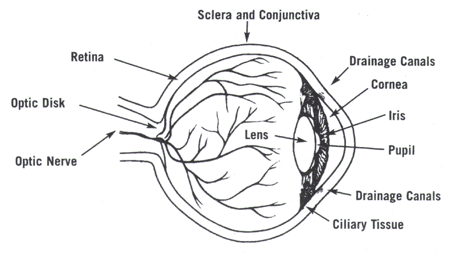Glaucoma Facts
What is glaucoma?
Glaucoma is a group of eye diseases that gradually steal sight without warning. In the early stages of the disease, there may be no symptoms. Experts estimate that half of the people affected by glaucoma may not know they have it. Vision loss is caused by damage to the optic nerve. This nerve acts like an electric cable with over a million wires. It is responsible for carrying images from the eye to the brain. There is no cure for glaucoma—yet. However, medication or surgery can slow or prevent further vision loss. The appropriate treatment depends upon the type of glaucoma among other factors. Early detection is vital to stopping the progress of the disease. It was once thought that high pressure within the eye, also known as intraocular pressure or IOP, is the main cause of this optic nerve damage. Although IOP is clearly a risk factor, we now know that other factors must also be involved because even people with “normal” levels of pressure can experience vision loss from glaucoma.

A tough white covering called the sclera protects the eye. Part of the white sclera can be seen in the front of the eye. A clear, delicate membrane called the conjunctiva covers the sclera. At the front of the eye is the cornea. The cornea is the clear part of the eye’s protective covering. It allows light to enter the eye. The iris is the colored part of the eye that shrinks and expands so the pupil can let just the right amount of light into the eye. The light is directed by the pupil to the lens. The lens focuses the light onto the retina (inside the lining of the eye). Nerve fibers in the retina carry light and images to the brain through the optic nerve.
Healthy drainage
The front part of the eye is filled with a clear fluid called intraocular fluid or aqueous humor, made by the ciliary body. The fluid flows out through the pupil. It is then absorbed into the bloodstream through the eye’s drainage system. This drainage system is a meshwork of of drainage canals around the outer edge of the iris. Proper drainage helps keep eye pressure at a normal level. The production, flow, and drainage of this fluid is an active continuous process that is needed for the health of the eye.
The inner pressure of the eye (intraocular pressure or IOP) depends upon the amount of fluid in the eye. If your eye’s drainage system is working properly than fluid can drain out and prevent a buildup. Likewise, if your eye’s fluid system is working properly, then the right amount of fluid will be produced for a healthy eye. Your IOP can vary at different times of the day, but it normally stays within a range that the eye can handle.
The eye with glaucoma
In most types of glaucoma, the eye’s drainage system becomes clogged so the intraocular fluid cannot drain. As the fluid builds up, it causes pressure to build within the eye. High pressure damages the sensitive optic nerve and results in vision loss.
The optic disc
You have millions of nerve fibers that run from your retina to the optic nerve. These fibers meet at the optic disc. As fluid pressure within your eye increases, it damages these sensitive nerve fibers and they begin to die. As they die, the disc begins to hollow and pushes the optic nerve into a cupped or curved shape. If the pressure remains too high for too long, the extra pressure can damage the optic never and result in vision loss.
The fluid inside
Aqueous humor is the clear, watery fluid that is continually produced inside the eye. It is different from your tears. Tears are produced by glands outside of the eye and moisten the outer surface of the eyeball.
Contact Provision to schedule your next visit!
For more detailed information on Glaucoma, visit www.glaucoma.org

